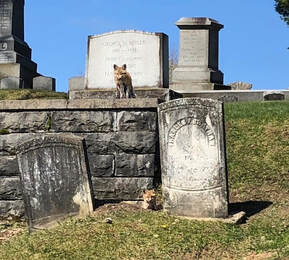|
5/10/2020 The Fox Family in the Local Cemetery There is a family of red fox in a cemetery nearby and they have become a welcome diversion from all of the doom and gloom of the Covid-19 pandemic. I've been finding myself wandering the cemetery in the early morning and evenings, hoping to observe the pups playing. When the mother comes around, I take off so as not to distract them from their feeding routine. Watching them from a distance allows me to keep my mind off of other pressing concerns (the health and safety of my family) and made me realize that as we humans struggle with the impacts of this terrible pandemic, mother nature just keeps forging on. Because the red fox appears in two of my novels, I researched their ecology. Fox mate in late winter and produce 2-10 young by March-April. The mother builds two dens (one is a back-up). They may dig their own or take over previous holes dug by gophers. It is not uncommon for the mother to divide the litter between two dens. Unlike some other mammals that leave the care of the young to the mother, fox mates stay together to bring up the pups. The male will bring food for the pups to play with and eat until they can hunt on their own (12 weeks). They are omnivores, meaning they eat both meat and plants. I've seen bird feathers and carcasses near the den and one day I spotted one of the parents coming over the hill with what looked like a squirrel in its mouth. They are mostly active in the early evening or night but while taking care of the young, the parents may be seen hunting near the den. Sometimes at night I can hear the screeching and yipping of fox that live in the fields near our house. It's slightly eerie and almost sounds like they are in pain. This form of communication is mostly between mates. After 12 weeks, the pups disperse - males going first, to stake out new territory. The coyote and man are the fox's natural predators. It is still legal to hunt fox in the U.S. but not as common as it used to be. While I was researching one of my novels I found a reference to residents of the Smoky Mountains during the Great Depression, hunting fox and other fur bearing mammals to send the pelts to Sears and Roebuck for five dollars a pelt. And of course many of us know about fox hunting with hounds which has been banned in most places. In the U.S. it is now considered a 'chase' and they don't kill the fox. Nowadays, the lethal risk to fox is the coyote, which is increasing in number in the Northeaster U.S. , and disease. Since the stay-at-home and social distancing began I've been walking three to four miles a day to keep my mind off things. Checking in on the fox family has become a ritual and has saved me from wallowing in despair. It has also served as a reminder that the Mother nature keeps moving on no matter what we humans do. We will survive all of this. If anything, slowing down, walking outdoors because the gyms are closed, has been a godsend for a lot of us because we're reconnecting with the natural world. Comments are closed.
|
AuthorSheila Myers is an award winning author and Professor at a small college in Upstate NY. She enjoys writing, swimming in lakes, and walking in nature. Not always in that order. Archives
April 2024
CategoriesAll Adirondacks Algonquin Appalachia Award Cades Cove Canada Chestnut Trees Christmas Civilian Conservation Corps Collis P. Huntington Creativity Doc Durant Durant Family Saga Emma Bell Miles Finger Lakes Great Depression Hell On Wheels Historical Fiction History Horace Kephart Imagination National Parks Nature Publishing Review Screenplay Short Story Smoky Mountains Snow Storm Stone Canoe Literary Magazine Thomas Durant Timber Wilderness World War II Writing |
|
|
All materials Copyright 2022
Any reproduction, reprint or publication without written consent of author prohibited. |
 RSS Feed
RSS Feed